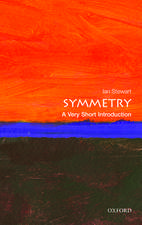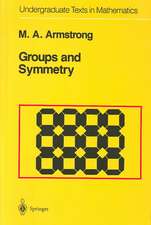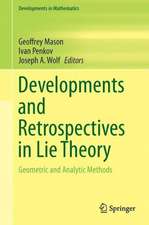Permutation Groups: Graduate Texts in Mathematics, cartea 163
Autor John D. Dixon, Brian Mortimeren Limba Engleză Hardback – 11 apr 1996
| Toate formatele și edițiile | Preț | Express |
|---|---|---|
| Paperback (1) | 458.39 lei 6-8 săpt. | |
| Springer – 30 sep 2012 | 458.39 lei 6-8 săpt. | |
| Hardback (1) | 591.96 lei 6-8 săpt. | |
| Springer – 11 apr 1996 | 591.96 lei 6-8 săpt. |
Din seria Graduate Texts in Mathematics
-
 Preț: 337.45 lei
Preț: 337.45 lei -
 Preț: 383.85 lei
Preț: 383.85 lei -
 Preț: 402.87 lei
Preț: 402.87 lei - 17%
 Preț: 528.66 lei
Preț: 528.66 lei - 17%
 Preț: 398.97 lei
Preț: 398.97 lei -
 Preț: 355.82 lei
Preț: 355.82 lei -
 Preț: 412.24 lei
Preț: 412.24 lei -
 Preț: 404.47 lei
Preț: 404.47 lei -
 Preț: 289.88 lei
Preț: 289.88 lei - 17%
 Preț: 365.79 lei
Preț: 365.79 lei - 17%
 Preț: 359.45 lei
Preț: 359.45 lei - 15%
 Preț: 488.70 lei
Preț: 488.70 lei -
 Preț: 381.92 lei
Preț: 381.92 lei - 13%
 Preț: 357.75 lei
Preț: 357.75 lei -
 Preț: 407.88 lei
Preț: 407.88 lei - 13%
 Preț: 352.49 lei
Preț: 352.49 lei - 13%
 Preț: 358.86 lei
Preț: 358.86 lei - 13%
 Preț: 393.48 lei
Preț: 393.48 lei - 11%
 Preț: 351.00 lei
Preț: 351.00 lei - 17%
 Preț: 359.58 lei
Preț: 359.58 lei -
 Preț: 350.45 lei
Preț: 350.45 lei - 8%
 Preț: 567.36 lei
Preț: 567.36 lei -
 Preț: 399.74 lei
Preț: 399.74 lei -
 Preț: 498.91 lei
Preț: 498.91 lei - 20%
 Preț: 571.26 lei
Preț: 571.26 lei - 15%
 Preț: 546.59 lei
Preț: 546.59 lei -
 Preț: 498.69 lei
Preț: 498.69 lei - 15%
 Preț: 354.39 lei
Preț: 354.39 lei -
 Preț: 313.10 lei
Preț: 313.10 lei - 13%
 Preț: 427.39 lei
Preț: 427.39 lei - 17%
 Preț: 363.59 lei
Preț: 363.59 lei -
 Preț: 340.18 lei
Preț: 340.18 lei - 17%
 Preț: 364.47 lei
Preț: 364.47 lei - 17%
 Preț: 366.47 lei
Preț: 366.47 lei - 17%
 Preț: 366.06 lei
Preț: 366.06 lei -
 Preț: 247.59 lei
Preț: 247.59 lei - 17%
 Preț: 367.70 lei
Preț: 367.70 lei - 13%
 Preț: 356.79 lei
Preț: 356.79 lei - 17%
 Preț: 398.78 lei
Preț: 398.78 lei - 17%
 Preț: 398.51 lei
Preț: 398.51 lei - 17%
 Preț: 496.63 lei
Preț: 496.63 lei - 15%
 Preț: 482.97 lei
Preț: 482.97 lei -
 Preț: 401.99 lei
Preț: 401.99 lei - 17%
 Preț: 366.56 lei
Preț: 366.56 lei - 20%
 Preț: 449.73 lei
Preț: 449.73 lei -
 Preț: 380.34 lei
Preț: 380.34 lei - 17%
 Preț: 427.27 lei
Preț: 427.27 lei
Preț: 591.96 lei
Preț vechi: 696.42 lei
-15% Nou
Puncte Express: 888
Preț estimativ în valută:
113.27€ • 118.58$ • 93.72£
113.27€ • 118.58$ • 93.72£
Carte tipărită la comandă
Livrare economică 05-19 aprilie
Preluare comenzi: 021 569.72.76
Specificații
ISBN-13: 9780387945996
ISBN-10: 0387945997
Pagini: 348
Ilustrații: XII, 348 p.
Dimensiuni: 155 x 235 x 22 mm
Greutate: 0.64 kg
Ediția:1996
Editura: Springer
Colecția Springer
Seria Graduate Texts in Mathematics
Locul publicării:New York, NY, United States
ISBN-10: 0387945997
Pagini: 348
Ilustrații: XII, 348 p.
Dimensiuni: 155 x 235 x 22 mm
Greutate: 0.64 kg
Ediția:1996
Editura: Springer
Colecția Springer
Seria Graduate Texts in Mathematics
Locul publicării:New York, NY, United States
Public țintă
GraduateCuprins
1. The Basic Ideas.- 1.1. Symmetry.- 1.2. Symmetric Groups.- 1.3. Group Actions.- 1.4. Orbits and Stabilizers.- 1.5. Blocks and Primitivity.- 1.6. Permutation Representations and Normal Subgroups.- 1.7. Orbits and Fixed Points.- 1.8. Some Examples from the Early History of Permutation Groups.- 1.9. Notes.- 2. Examples and Constructions.- 2.1. Actions on k-tuples and Subsets.- 2.2. Automorphism Groups of Algebraic Structures.- 2.3. Graphs.- 2.4. Relations.- 2.5. Semidirect Products.- 2.6. Wreath Products and Imprimitive Groups.- 2.7. Primitive Wreath Products.- 2.8. Affine and Projective Groups.- 2.9. The Transitive Groups of Degree at Most 7.- 2.10. Notes.- 3. The Action of a Permutation Group.- 3.1. Introduction.- 3.2. Orbits of the Stabilizer.- 3.3. Minimal Degree and Bases.- 3.4. Frobenius Groups.- 3.5. Permutation Groups Which Contain a Regular Subgroup.- 3.6. Computing in Permutation Groups.- 3.7. Notes.- 4. The Structure of a Primitive Group.- 4.1. Introduction.- 4.2. Centralizers and Normalizers in the Symmetric Group.- 4.3. The Socle.- 4.4. Subnormal Subgroups and Primitive Groups.- 4.5. Constructions of Primitive Groups with Nonregular Socles.- 4.6. Finite Primitive Groups with Nonregular Socles.- 4.7. Primitive Groups with Regular Socles.- 4.8. Applications of the O’Nan-Scott Theorem.- 4.9. Notes.- 5. Bounds on Orders of Permutation Groups.- 5.1. Orders of Elements.- 5.2. Subgroups of Small Index in Finite Alternating and Symmetric Groups.- 5.3. The Order of a Simply Primitive Group.- 5.4. The Minimal Degree of a 2-transitive Group.- 5.5. The Alternating Group as a Section of a Permutation Group.- 5.6. Bases and Orders of 2-transitive Groups.- 5.7. The Alternating Group as a Section of a Linear Group.- 5.8. Small Subgroups of Sn.- 5.9. Notes.- 6. The MathieuGroups and Steiner Systems.- 6.1. The Mathieu Groups.- 6.2. Steiner Systems.- 6.3. The Extension of AG2(3).- 6.4. The Mathieu Groups M11and M12.- 6.5. The Geometry of PG2(4).- 6.6. The Extension of PG2(4) and the Group M22.- 6.7. The Mathieu Groups M23and M24.- 6.8. The Geometry of W24.- 6.9. Notes.- 7. Multiply Transitive Groups.- 7.1. Introduction.- 7.2. Normal Subgroups.- 7.3. Limits to Multiple Transitivity.- 7.4. Jordan Groups.- 7.5. Transitive Extensions.- 7.6. Sharply k-transitive Groups.- 7.7. The Finite 2-transitive Groups.- 7.8. Notes.- 8. The Structure of the Symmetric Groups.- 8.1. The Normal Structure of Sym(?).- 8.2. The Automorphisms of Sym(?).- 8.3. Subgroups of F Sym(?).- 8.4. Subgroups of Small Index in Sym(?).- 8.5. Maximal Subgroups of the Symmetric Groups.- 8.6. Notes.- 9. Examples and Applications of Infinite Permutation Groups.- 9.1. The Construction of a Finitely Generated Infinite p-group.- 9.2. Groups Acting on Trees.- 9.3. Highly Transitive Free Subgroups of the Symmetric Group.- 9.4. Homogeneous Groups.- 9.5. Automorphisms of Relational Structures.- 9.6. The Universal Graph.- 9.7. Notes.- Appendix A. Classification of Finite Simple Groups.- Appendix B. The Primitive Permutation Groups of Degree Less than 1000.- References.















